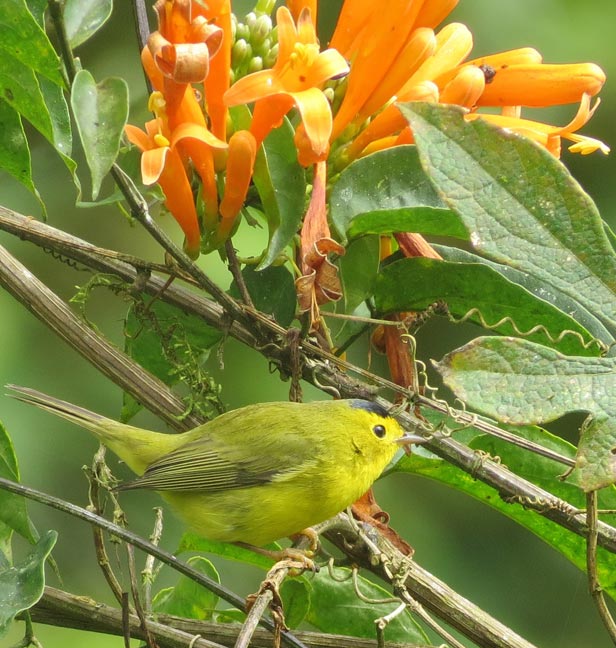Birds Flying High Over the Great Lakes Have a New Strategic Plan

Wilson's Warblers a re common migrant passing through the Great Lakes region each spring and fall.
Every year, many bird researchers catch warblers, finches, thrushes and other feathered travelers to better understand their routes and migration patterns. A number of conservation initiatives seek to secure land to help species make their trek thousands of miles southward. But without a collective vision, these efforts may not be enough to protect birds in the Great Lakes region.
Amber Roth, a research assistant professor in the School of Forest Resources and Environmental Science at Michigan Technological University, is working on that vision. Along with partners around the Great Lakes, Roth oversees the Midwest Landbird Migration Monitoring Network and has helped develop a strategic plan to dovetail research and conservation.
“Our goal is to work on coordination, to focus on big picture questions that we have regionally and try to bring people together,” Roth says. “With birds, we have to think in three dimensions,” she adds, especially since migration remains a mysterious part of birds’ lives. Researchers delve into avian winter and summer grounds, but it’s much harder to understand their migration paths and habits.
“There’s a variety of information we can get from a bird in the hand, and it’s an opportunity to ask additional questions with people who are already catching birds,” Roth say. The network is building off existing research projects.
The additional questions are ones she hopes to develop through the network and could include looking into airspace heavily used in migration, quantifying the impacts of land use on forest birds and establishing research protocols. The list is long, Roth admits, so “we want to key into a few questions that we want to answer as a region.”
Once Roth and the network’s steering committee have a set of questions, the next step will be to address them through supporting and expanding research.
“The other component of the research is implementing what is being learned — that’s the conservation side of this initiative,” Roth says. Informed conservation, she explains, is the driving force of the strategic plan. “You could have great habitat on a highway median, but is that really where you want a bunch of birds to be concentrated?”
Identifying important stopover areas for migratory birds is part of the plan; rethinking reclamation is another part, which is possible on industrial and lawn scales.
“There are win-win opportunities with recovering sites that are degraded,” Roth says of the many old industrial and commercial sites along Great Lakes shores. But smaller, backyard restoration is also important for making better migration corridors and habitat for birds, and yard habitat can be certified through the National Wildlife Federation. “Even if you think, ‘Oh, I have hardly any yard,’ it’s amazing the difference one little yard can make. This is something everyone can participate in.”
To that end, Roth hopes to extend their partnerships to tribal agencies, municipalities, 4H groups, local conservation clubs and other initiatives at all scales. As an example, on the Michigan Tech campus, Roth helped students set up a research project investigating bird-window collisions.
“Creating 150 conservation projects is beyond my abilities as coordinator, that’s where we need partners,” Roth says. So far the network is working with 18 partners and hopes to expand over the next several years.
Anyone interested in joining the network can view the strategic plan on the Midwest Coordinated Bird Monitoring Partnership website.
Contact Information
Amber Roth
Michigan Technological University
amroth@mtu.edu
Phone: (715) 525-2102
Media Contact
All latest news from the category: Life Sciences and Chemistry
Articles and reports from the Life Sciences and chemistry area deal with applied and basic research into modern biology, chemistry and human medicine.
Valuable information can be found on a range of life sciences fields including bacteriology, biochemistry, bionics, bioinformatics, biophysics, biotechnology, genetics, geobotany, human biology, marine biology, microbiology, molecular biology, cellular biology, zoology, bioinorganic chemistry, microchemistry and environmental chemistry.
Newest articles

Silicon Carbide Innovation Alliance to drive industrial-scale semiconductor work
Known for its ability to withstand extreme environments and high voltages, silicon carbide (SiC) is a semiconducting material made up of silicon and carbon atoms arranged into crystals that is…

New SPECT/CT technique shows impressive biomarker identification
…offers increased access for prostate cancer patients. A novel SPECT/CT acquisition method can accurately detect radiopharmaceutical biodistribution in a convenient manner for prostate cancer patients, opening the door for more…

How 3D printers can give robots a soft touch
Soft skin coverings and touch sensors have emerged as a promising feature for robots that are both safer and more intuitive for human interaction, but they are expensive and difficult…





















